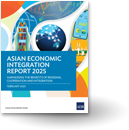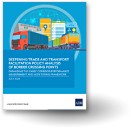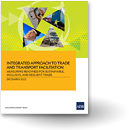More than just money: Digital technologies can help narrow the trade finance gap
Digital or financial technology—including mobile internet access, blockchain, artificial intelligence, and big data—can make international trade more efficient and support financing options.
Trade finance provides exporters and importers with effective tools to manage working capital and reduce risks related to trading across borders. Around 40% of global international trade is financed by banks through trade finance transactions such as letters of credit, loans, and guarantees. There are around $1.5 trillion of rejected trade finance applications globally in 2018, which is as much as 8% of global goods trade, according to the recent report, Trade Finance Gaps, Jobs, and Growth Survey. The Asia-Pacific region accounts for 40% of the total rejection.
The lack of financing acts as a significant barrier to trade, particularly for small and medium-sized enterprises in developing economies. These businesses are most affected as they tend to have higher rejection rates relative to larger firms. Around half of the rejections originate from small and medium sized enterprises. The survey shows that around 44% of the firms with rejected trade finance applications were unable to find appropriate alternative financing.
Here are three major challenges in meeting the unmet need for trade finance:
Inefficiencies from paper-based transactions. A significant number of trade finance transactions still rely on paper-based documentation which is prone to delays and human error. Manual processing and handling can cause many payment errors, thus lead to delays in payment or even non-payment of transactions. For example, letter of credit transactions which are often paper-based may lead to multiple potential risk points including delays, additional costs incurred by manual labor, and financial fraud.
Regulatory compliance requirements. Compliance with anti-money laundering and know-your-customer regulations is an intensive process for both banks and firms. A majority of banks identify these requirements as one of the largest challenges for the industry to grow, although they are necessary to ensure sound cross-border transactions. Also, the new Basel III standards require banks to have more regulatory capital and liquidity.
Information asymmetry. The third challenge is related to the fact that the amounts of information that lenders and borrowers have are different&mdashlso-called information asymmetry. Lenders usually require collateral or information on borrowers such as credit history to mitigate risks. Such requirements may not be available for some small businesses. Or it could be costly for banks to obtain, especially when dealing with small and medium-sized enterprises where the loan amounts and profits are small relative to the needs of bigger firms. Ironically, requirements to reduce information asymmetry may add more challenges to access to trade financing.
Fintech or financial technology makes use of mobile internet access, blockchain, artificial intelligence, and big data to improve access to information with fewer security concerns. These technologies can help improve efficiencies substantially at various stages of international trade. They help address the three challenges previously mentioned, and therefore draw more small and medium-sized enterprises into global trade.
For example, electronic bills of lading and other e-documents can greatly enhance process efficiency by reducing paperwork and facilitating transactions with customs. Blockchain and artificial intelligence can facilitate due diligence and payments for small businesses that have difficulty finding representative banks. Fintech firms using big data coupled with artificial intelligence can ease the costs of asymmetric information by providing alternate (non-bank) credit information.
We should note that digitalization is far from complete. High implementation costs are one reason it is not happening right now. A recent survey by the International Chamber Commerce shows that roughly 40% of responding banks said that digitalization was not part of their immediate agenda. Banks also find that the high cost of technology adoption is the biggest impediment in technology adoption, followed by lack of global standards, laws and rules for digital finance.
How can we strengthen our support for small and medium-sized enterprise trade finance through digital technology? It is important to create an environment in the medium to long term that can facilitate the adoption of digital technologies in trade finance. International standards in technology should also be encouraged to ensure interoperability and compatibility of various systems.
Three global initiatives are worth receiving support. First, the Digital Standards for Trade initiative aims to develop digital standards so different systems can be interoperable in the trade ecosystem. Next, the Global Legal Entity Identifier system can provide a global harmonized identity for all companies, large and small. It promotes transparency and security by enabling firms to have a unique identity. Thirdly, there has been little recognition or adoption of a legal framework nationally. E-title documents, e-promissory notes, and e-bills of lading are not yet recognized as legally equivalent to paper-based trade documents. Therefore, model laws created by the United Nations Commission on International Trade Law can help implement legislation toward paperless trade.
In parallel, national government and regional institutions should increase their support for trade finance, for example, through export credit agencies and trade finance programs. Knowledge gaps should be reduced since small and medium-sized enterprises often lack awareness of trade finance products and public assistance programs.
Original article was published at the ADB Blog and duplicated here with permission from the author. *




